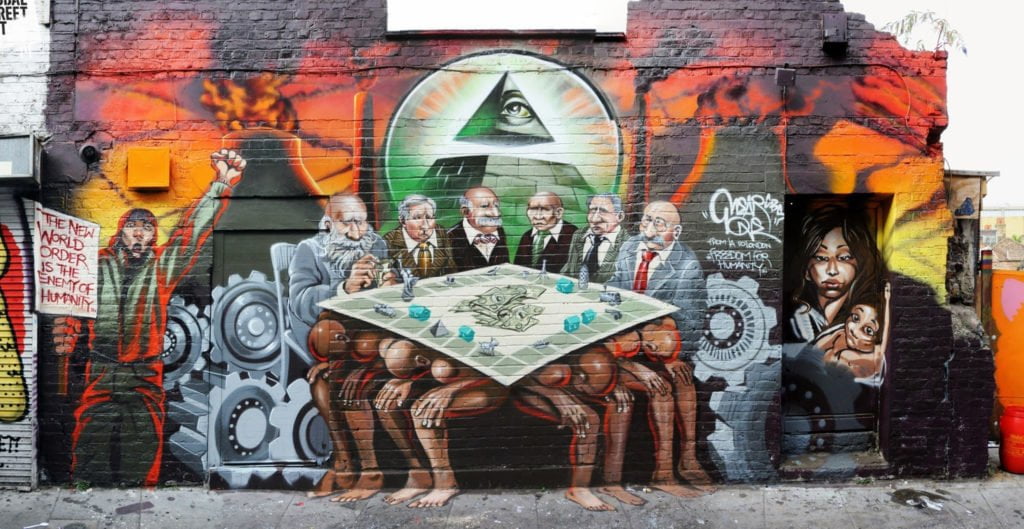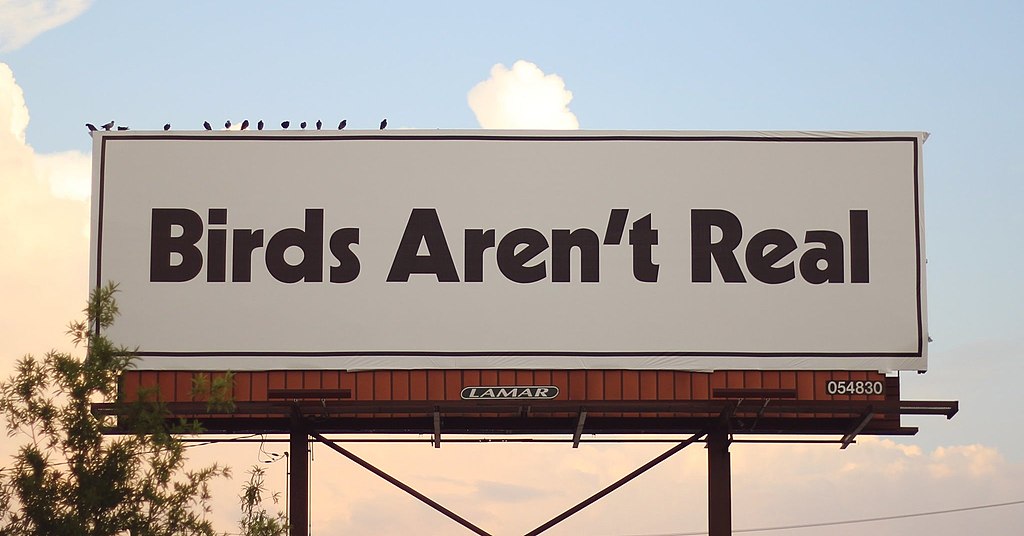On 18 June 2023, a small five-person submarine was destroyed by the combined navies of the US, UK, and Russia to protect a secret undersea mining operation. In December of 2022, agents acting on behalf of the Federal Reserve Bank of the United States (the Fed) met and compelled singer Taylor Swift to embark on the Eras tour to help repair US President Joe Biden’s economy. Currently, the nation of Australia is causing the nation of Tuvalu to sink beneath the sea so that its citizens would migrate to Australia. Actor Matthew Perry’s drowning death was an assassination to distract people from Israel’s war in Gaza. I’m sure you’ve heard the theory that we live in a computer simulation. That theory is clearly bunk, but what is true is that planet Earth is a setting for a reality show watched by a superior alien race.
None of these theories should sound familiar, unless they’re on Twitter, I don’t know – I took myself off Twitter so, someone could be pushing those specific theories. They all sound a little familiar in that they orbit other more popular theories, however, it’s very likely you’ve never heard those specific ideas, because they are the products of an assignment that I gave my students at the end of last semester.
In my regular life I am a college lecturer who teaches a course titled “Conspiracy Theories, Skepticism, and Critical Thinking.” The course isn’t a survey of popular conspiracy theories but part of my school’s requirement that first-year students learn how to write university-level papers. My goal in this course is to impart the skill of reasoning and correct research methodology to them. Conspiracy theories offer a great example of what not to do.
The reason that the course is not a mere survey is that, while interesting in an encyclopaedic sense, they do not help us understand how conspiracy theories work and why they are an overall detriment to society. Obviously, I cannot teach this kind of course without using a wide variety of examples, but the course isn’t about disproving the theories by picking them apart. We’ve discussed on this site that facts in isolation do not work to dissuade them.
As an example, I discuss the Illuminati in a lecture about “secret societies.” I explain that what started as an 18th century nerd club for Deists became the focal point for evil according to conspiracy theorists. I trace a line from Adam Weishaupt to David Icke, while explaining that each step required a new layer of incredulity. I point out that the bad reasoning could have been avoided if anyone (especially during the Satanic Panic of the 80s and 90s) had just stopped, looked around, and asked if any of this were even possible. I try to implement the slogan “reason with compassion” and instruct that even well meaning, intelligent people can fall into the trap of conspiracy theorising (I do not include grifters in this category).

The best method of tackling the subject is not to address the problem after someone’s been exposed, but before. Inoculation is a much better option than treatment, and it’s easier to stop someone from getting sucked in than to drag them out. If a person knows the tactics of a conspiracy theorist prior to encountering one, it makes them less likely to fall into their trap. If you know what a “Bewilder Gambit” is you can hopefully see it happening and ask the person to explain all the “science-sounding words.” This won’t stop the theory, or convince the believer to abandon it, but it does help prevent people from believing it by providing a break between all the technobabble designed to give glassy-eyed listeners the impression of expertise. Inoculation against conspiracy theories is just like vaccination – it doesn’t make us 100% immune, but it does make it less likely that we catch the condition.
The traditional way to confer this vaccination would be to drill the students on things like informal fallacies (ie ad hominem, post hoc ergo propter hoc, begging the question, etc) What happens in that method, however, is that the students get a vocabulary lesson rather than a practical lesson for the future. Instead, the skill is to get the student to see the internal workings of a conspiracy theory. Arming the students with the facts and fallacies is an exercise in abstraction. Sure, they know the proper definition of “begging the question” (it does not mean “raises the question”) but knowing what it is and knowing how it operates in the confines of a book like Alex Jones’ The Great Reset are two entirely different things. Understanding that he (his ghost writer actually) sat down and made a self-referential argument, then pulled it out of context to make their theory seem valid, is more important than knowing the Wikipedia definition of it.
When one of my students has spent time pulling quotes out of context to make one of those strange theories (although the Swift one is no longer strange by comparison) or when they’ve take two unrelated events and woven them together in the most gossamer of connections, the hope is that they now understand that anyone can make a conspiracy theory, and so perhaps the seed of skepticism has been planted. As the American election season begins, they should know that when a certain news channel begins wall-to-wall coverage of a migrant caravan based on flimsy connections, they’ll see the pattern being used to push an emotion. Hopefully these specific students were able to use this lesson to spot the fake panic used when an unfortunate accident happened at the US-Canada border (also a few miles from my house). My hope is that they think to themselves, “Oh right, this is like when I made up the story about Tuvalu.”
Reading these assignments is where I learned about Oceangate and mining, Taylor Swift and the Federal Reserve Bank, Matthew Perry and the war, the sinking of Tuvalu, and Planet Earth: the Show. Those were the best submissions, but they were all pretty good except for one that just ripped off an existing theory about Hitler in South America. In some cases, like the one about Swift, the conspiracy theories were more plausible than ones pushed by “professionals.”

I’ve been warned that there is some danger in this. The first risk is that by encouraging my students to create conspiracy theories, they will begin to spread theirs around. This is a problem that even my dissertation advisor was warned about when he gave a similar assignment to one of his classes. I don’t feel that this worry is legitimate. The hypothetical student would have to be very cynical and completely ignorant of the intent of the assignment.
The only true danger is that I have sent them into the conspiracy internet to find examples, and that exposes them to other conspiracy theories, one of which may hook them. I take this seriously enough that they are only given these assignments after I’ve spent a considerable amount of class time explaining how conspiracy theories work.
The purpose of the assignment is to “prebunk” or inoculate them against conspiracy theorising. There is research that suggests this method has some effectiveness concerning topics such as global warming. Typical prebunking is done by showing the conspiracy theories’ hand before they play the card. By taking the sting out of the reveal, the conspiracy theory loses its edge. Prebunking gets ahead of the conspiracy theory, which cannot grab the emotional hold if the audience already knows the punchline.
While some conspiracy theories will exploit already existing fears, anxieties, and hatreds, they do so by adding something new to it. The Flat Earth conspiracy petered out because, among other reasons (the Pandemic for one), they didn’t have much they could add to the theory.
Typical prebunking is about providing the factoids that make up the theory; my intent in this assignment is to prebunk the methods of conspiracy theorists. I want the skeleton to be unsurprising and bland, rather than the meat and blood of the theory. This is why the second part of the assignment is necessary—the student is required to explain how they constructed the theory. They have to walk through where, for example, they found the undersea mining “evidence”; the federal reserve agents, or the migration plan. This aspect of the assignment creates an awareness that I hope is translatable to the larger world so that when they see a new conspiracy theory hitting the same rhythm of their own, they’ll be aware that they should view this new explanation with skepticism.
So, while I’ve sent them into the underdark of the internet to find conspiracy theories, the hope is that they can learn the path enough to prevent them from getting hooked on a future conspiracy theory.



